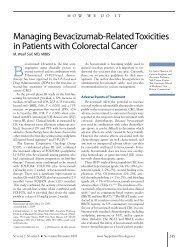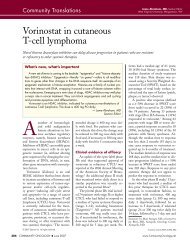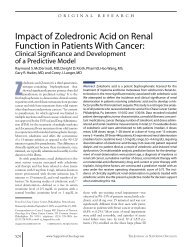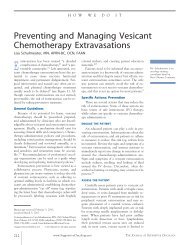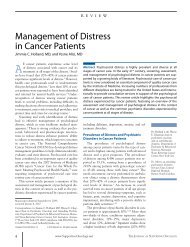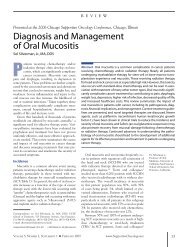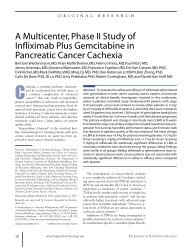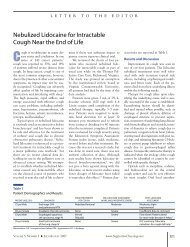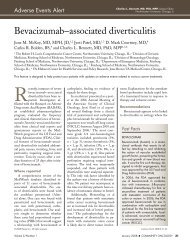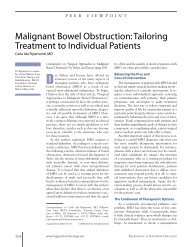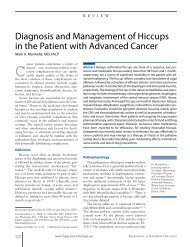Visual Analogue Scales and Assessment of Quality of Life in Cancer
Visual Analogue Scales and Assessment of Quality of Life in Cancer
Visual Analogue Scales and Assessment of Quality of Life in Cancer
Create successful ePaper yourself
Turn your PDF publications into a flip-book with our unique Google optimized e-Paper software.
<strong>Visual</strong> <strong>Analogue</strong> <strong>Scales</strong> <strong>and</strong> <strong>Assessment</strong> <strong>of</strong> <strong>Quality</strong> <strong>of</strong> <strong>Life</strong> <strong>in</strong> <strong>Cancer</strong><br />
Prostate cancer. The PrOSQOLi has n<strong>in</strong>e vASs assess<strong>in</strong>g<br />
physical symptoms (appetite, constipation, fatigue, pa<strong>in</strong>,<br />
pass<strong>in</strong>g ur<strong>in</strong>e, physical activity), mood, family, <strong>and</strong> global<br />
well-be<strong>in</strong>g. 29,30 items correlate moderately with the eOrTC<br />
QLQ-C30. it discrim<strong>in</strong>ates patients by performance status,<br />
hemoglob<strong>in</strong> level, analgesic score, <strong>and</strong> survival. it has demonstrated<br />
improved overall QOL <strong>in</strong> advanced hormone-refractory<br />
prostate cancer patients who responded to mitoxantrone<br />
<strong>and</strong> prednisolone. 30<br />
PROXY MEASURES OF QOL<br />
A vAS may also be used to evaluate specific doma<strong>in</strong>s <strong>of</strong><br />
QOL (eg, <strong>in</strong>dividual symptoms or psychological concerns).<br />
S<strong>in</strong>gle-item VASs. S<strong>in</strong>gle-item vASs are valid for assessment<br />
<strong>of</strong> pa<strong>in</strong> <strong>and</strong> depression <strong>in</strong> cancer. 48,49 They are useful <strong>in</strong> cl<strong>in</strong>ical<br />
trials when change <strong>in</strong> <strong>in</strong>dividual symptoms is expected. They<br />
may be paired with a s<strong>in</strong>gle-item QOL scale to <strong>in</strong>vestigate the<br />
impact <strong>of</strong> symptoms on overall QOL. 15<br />
Edmonton Symptom <strong>Assessment</strong> Scale (ESAS). The eSAS<br />
was designed for palliative populations. N<strong>in</strong>e vASs evaluate<br />
symptoms (activity, anxiety, appetite, depression, drows<strong>in</strong>ess,<br />
pa<strong>in</strong>, nausea, shortness <strong>of</strong> breath, <strong>and</strong> well-be<strong>in</strong>g); scores are<br />
summated to a distress score. 50 it is valid with <strong>in</strong>ternal consistency<br />
<strong>and</strong> test-retest reliability. 51 <strong>in</strong>terrater studies reveal an<br />
overestimation <strong>of</strong> symptoms by caregivers <strong>and</strong> an underestimation<br />
<strong>of</strong> symptoms by physicians. 50,52 The completion rates<br />
vary by stage <strong>of</strong> disease. Most general oncology patients can<br />
complete it on hospital admission, compared with 63%–84%<br />
<strong>of</strong> palliative medic<strong>in</strong>e cancer patients <strong>and</strong> only 15% <strong>of</strong> term<strong>in</strong>al<br />
patients. 50,51,53 rout<strong>in</strong>e use <strong>of</strong> eSAS on admission to a<br />
palliative medic<strong>in</strong>e unit has shown significant underassessment<br />
<strong>and</strong> documentation <strong>of</strong> symptoms, especially <strong>in</strong>activity,<br />
impaired well-be<strong>in</strong>g, <strong>and</strong> anxiety. 54<br />
The Distress Thermometer. The Distress Thermometer is a<br />
modified vAS: a vertical thermometer numbered 0–10 with<br />
the words no distress, moderate distress, <strong>and</strong> severe distress<br />
along the scale. 55–57 it has a 34-item problem checklist, <strong>in</strong>clud<strong>in</strong>g<br />
physical <strong>and</strong> psychosocial concerns. it is validated<br />
<strong>in</strong> cancer populations <strong>and</strong> advocated for rout<strong>in</strong>e screen<strong>in</strong>g. 58<br />
Scores <strong>of</strong> at least 4 are recommended as the trigger for further<br />
evaluation <strong>and</strong> <strong>in</strong>tervention. There is no evidence as to the<br />
association between Distress Thermometer scores <strong>and</strong> QOL<br />
or cl<strong>in</strong>ical outcomes from rout<strong>in</strong>e screen<strong>in</strong>g.<br />
Methodologic Issues<br />
Many studies validat<strong>in</strong>g QOL <strong>in</strong>struments are convenience<br />
or cl<strong>in</strong>ical trial samples. This fact potentially limits the relevance<br />
<strong>of</strong> these <strong>in</strong>struments to selected populations. Other<br />
methodologic issues <strong>in</strong>clude the potential for measurement<br />
error <strong>and</strong> their unsuitability for telephone follow-up. Scor<strong>in</strong>g<br />
a vAS requires measurement rather than simply read<strong>in</strong>g from<br />
a paper, potentially add<strong>in</strong>g a source <strong>of</strong> error. vAS questionnaires<br />
must be pr<strong>in</strong>ted <strong>in</strong>dividually, as photocopy<strong>in</strong>g can distort<br />
the length <strong>of</strong> the l<strong>in</strong>e, lead<strong>in</strong>g to <strong>in</strong>consistent scor<strong>in</strong>g. A<br />
vAS can be computerized, thereby avoid<strong>in</strong>g such difficulties.<br />
At this time, however, only the LCSS has reported results with<br />
an electronic version. 47<br />
Consensus is lack<strong>in</strong>g about the statistical analysis <strong>of</strong> vAS<br />
data. 59,60 issues <strong>in</strong>volve whether the data are ord<strong>in</strong>al or ratio<br />
<strong>and</strong> whether scores are normally distributed <strong>and</strong> thus applicable<br />
for parametric analysis. Comparison <strong>of</strong> parametric (with<br />
<strong>and</strong> without transformation) <strong>and</strong> nonparametric analysis <strong>of</strong><br />
vAS pa<strong>in</strong> scores suggested that parametric tests were accurate<br />
<strong>and</strong> had the greatest power to detect a difference, despite<br />
a lack <strong>of</strong> normal distribution <strong>of</strong> the data. 61<br />
COMPLETION RATES<br />
Completion <strong>of</strong> a vAS requires conceptualization <strong>of</strong> a complex<br />
experience to a s<strong>in</strong>gle l<strong>in</strong>e. vAS pa<strong>in</strong> scales have lower<br />
completion rates than numerical or categorical scales. 62,63<br />
rates are adversely affected by <strong>in</strong>creas<strong>in</strong>g age, higher opioid<br />
dose, <strong>and</strong> the presence <strong>of</strong> confusion. 62,63 Tra<strong>in</strong><strong>in</strong>g <strong>in</strong> vAS technique<br />
is more time-consum<strong>in</strong>g than for other rat<strong>in</strong>g scales. 64<br />
<strong>in</strong> QOL studies, the Uniscale has a similar completion rate to<br />
other multi-item <strong>in</strong>struments. 23 Both the PrOSQOLi28 <strong>and</strong><br />
LCSS43 have high completion rates (> 80%) <strong>in</strong> cl<strong>in</strong>ical trials.<br />
The eSAS completion rate decl<strong>in</strong>es with advanc<strong>in</strong>g disease.<br />
SENSITIVITY<br />
vASs are said to be more sensitive to subjective changes<br />
than are numerical or categorical scales. However, it is unclear<br />
whether such high sensitivity is cl<strong>in</strong>ically relevant. Studies <strong>of</strong><br />
QOL <strong>in</strong> cardiac <strong>and</strong> respiratory failure have demonstrated<br />
a 7-po<strong>in</strong>t verbal descriptor scale had equal sensitivity to a<br />
vAS. 64,65 validation <strong>of</strong> a 0–10 numerical LCSS demonstrated<br />
good agreement with a vAS. 42 Comparison <strong>of</strong> a vAS <strong>in</strong><br />
the PrOSQOLi with equivalent Likert scales <strong>of</strong> the eOrTC<br />
QLQ-C30 demonstrated superior sensitivity <strong>of</strong> the vAS for<br />
pa<strong>in</strong> <strong>and</strong> other physical symptoms. 28 All scales differentiated<br />
treatment groups, but the vAS was less sensitive <strong>in</strong> complex<br />
doma<strong>in</strong>s like family <strong>and</strong> emotional function.<br />
CLINICAL SIGNIFICANCE<br />
Small changes on a vAS (eg, 0–5 mm) may be statistically<br />
significant but cl<strong>in</strong>ically irrelevant. The cl<strong>in</strong>ical significance<br />
can be evaluated by compar<strong>in</strong>g vAS scores with a global<br />
change scale (eg, from much better to much worse). For acute<br />
pa<strong>in</strong>, the m<strong>in</strong>imal cl<strong>in</strong>ically significant vAS change is 13<br />
mm. 66 <strong>in</strong>direct LCSS analysis supported cl<strong>in</strong>ically significant<br />
changes <strong>of</strong> 10–25 mm. 67 Cl<strong>in</strong>ically significant change has been<br />
suggested as 50% <strong>of</strong> the scale’s st<strong>and</strong>ard deviation (ie, 8–10<br />
mm on a 100-mm vAS). 21 This result would be equivalent to<br />
a change <strong>of</strong> 1 on an 11-po<strong>in</strong>t numerical scale.<br />
Instrument Selection<br />
Several factors affect the selection <strong>of</strong> an <strong>in</strong>strument. Population<br />
characteristics (<strong>in</strong>clud<strong>in</strong>g age, diagnosis, <strong>and</strong> performance<br />
status) affect completion rates <strong>and</strong> whether a diseasespecific<br />
or general questionnaire is appropriate. <strong>in</strong> research,<br />
the def<strong>in</strong>ition <strong>and</strong> hypothesis <strong>in</strong>fluence this choice, particu-<br />
280 www.SupportiveOncology.net th e Jo u r N A l o f su p p o rt i V e oN c o l o g y



